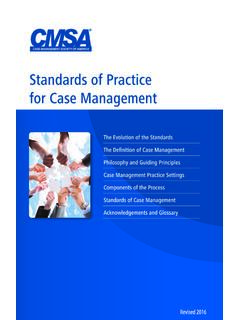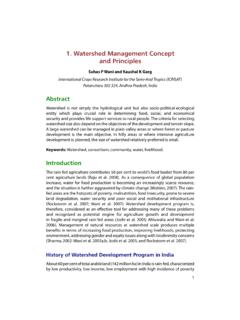Transcription of Standards of Practice for Case Management
1 Standards of Practice for Case ManagementRevised 2010 The Evolution of the StandardsThe Definition of Case ManagementPhilosophy and Guiding PrinciplesCase Management Practice SettingsComponents of the ProcessStandards of Case ManagementAcknowledgements and GlossaryStandards of Practice for Case Management , Revised 2010 CMSA Standards of Practice for Case Management 1 Case ManagementSociety of America6301 Ranch DriveLittle Rock, Arkansas 72223T E Management SOCIETY OF AMERICAS tandards of Practicefor Case Management , Revised 2010 2010 All rights of Contents Foreword ..2 Preface ..3I. INTRODuCTION ..4II. EvOLuTION OF ThE S TANDARDS OF P RACTICE FOR C ASE Management ..6 A. Standards of Practice for Case Management (1995) ..6 B. Standards of Practice for Case Management (2002) ..6 C. Standards of Practice for Case Management (2010) ..7 III. DEFINITION OF C ASE Management ..8Iv.
2 PhILOSOPhY AND GuIDING P RINCIPLES ..9A. Statement of Philosophy ..9 B. Guiding principles ..9v. CASE Management P RACTICE S ETTINGS ..11vI. CASE Management R OLES, FuNCTIONS, AND A CTIvITIES ..12vII. COMPONENTS OF ThE C ASE Management PROCESS ..14vIII. Standards OF CASE Management Practice ..15A. Client Selection Process for Case Management ..15B. Client Assessment ..15C. Problem/Opportunity Identification ..16D. Planning ..16E. Monitoring ..17F. Outcomes ..17G. Termination of Case Management Services ..17h. Facilitation, Coordination, and Collaboration ..18I. Qualifications for Case Managers ..19J. Legal ..191. Confidentiality and Client Privacy ..192. Consent for Case Management Services ..19K. Ethics ..20L. Advocacy ..20M. Cultural Competency ..21N. Resource Management and Stewardship ..21O. Research and Research utilization ..22IX. ACKNOwLEDGEMENTS ..23X. GLOSSARY ..24 References.
3 27 ForewordIt is our pleasure to present the 2010 revision of the Case Management Society of America s (CMSA) Standards of Practice for Case Management (SoP). These Standards were first published in 1995 and revised in 2002. Today, as our nation faces ever-changing challenges to our health care system, CMSA recognized the need to revise the Standards of Practice to be more reflec-tive of the rapidly growing and expanding role of case managers and the increased awareness of case managers as crucial members of the health care team. These key issues, among others, provided the impetus to re-examine and redefine our role in the current health care our profile becomes ever more visible, it is critical that we examine ourselves and set Standards by which we must be held accountable. Among the many changes to this edition, one of special note is the revised qualifications language. To establish our position as providers of service and to improve our position for reimbursement of case Management services, it is imperative to establish accepted qualifications for case managers.
4 Equally important, it is es-sential to validate our positive outcomes as we work with patients through case Management interventions. Ultimately, by clarifying our qualifications and validating outcomes achieved, the Standards of Practice will strengthen the case Management edition of the Standards of Practice is the product of many hours of labor, research, and deliberation among those who served on the task force, reference committees, case managers at-large, and the CMSA Board of Directors, who ultimately approves the Standards of Practice . There are many people to thank for their role in this revision. First, we must acknowledge Peter Moran who had the wisdom to call for the revision during his presidency and the foresight to ask Carrie Marion to lead the task force. we would also like to recognize the efforts of Cheri Lattimer and Danielle Marshall who have shepherded and supported the project over the past two , we would like to thank you, the case managers, for providing service to those in need, and for being part of what is right in health care through your passion and time from conception to fruition of this edition of our Standards of Practice has spanned three CMSA presidencies, and we are grateful to have been part of this historic moment-in-time for case managers and CMSA.
5 Jeff Frater, RN, BSN, CMSA President (2008 2009)Margaret Peggy Leonard, MS, RN-BC, FNP, CMSA President (2009 2010)2 CMSA Standards of Practice for Case ManagementCMSA Standards of Practice for Case Management 3 Preface The Standards of Practice for Case Management were first introduced by the CMSA in 1995 and then revised in 2002. we are pleased to offer the Standards of Practice for Case Management , 2010 revision, which provides voluntary Practice guidelines for the case Management industry. The Standards of Practice are intended to identify and address important foundational knowledge and skills of the case manager within a spectrum of case Management Practice settings and 2010 Standards reflect many changes in the industry, which resonate with current Practice today. Some of these changes include the following: Minimizing fragmentation in the health care system, using evidence-based guidelines in Practice , navigating transitions of care, incorporating adherence guidelines and other stan-dardized Practice tools, expanding the interdisciplinary team in planning care for individuals, and improving patient safety.
6 We believe that these are all important factors that case managers need to address in their practices . The 2010 Standards of Practice contain information about case Management Practice , including definition, Practice settings, roles, functions, activities, case Management process, philosophy and guiding principles , as well as the Standards and how they are dem-onstrated. This document is intended for voluntary use and is not intended to replace relevant legal or professional Practice 2010 Standards of Practice were developed through the efforts of dedicated case managers who spent countless hours synthesizing information over two public comment peri-ods to develop this document. The teams include: (1) A core task force made up of representatives of the case Management field in various Practice settings and disciplines(2) A larger reference group that included the CMSA leadership and Board of Directors, legal advisors, and the case Management industry (3) Other case Management experts in the industry (4) Case managers at-large during the Public Comment periodIt has been my pleasure to work on this project with the talented and committed individu-als who are raising the bar of excellence in the field of case Management .
7 Carrie Marion, RN, BSN, CCMC ommittee ChairThe consistent delivery of quality health care services and the high financial cost generally associated with those services are important concerns that touch everyone, from our leaders in washington, to the American public. Payers continue to seek methods for reducing costs while advancing quality and transparency. Providers explore methods to define and report quality while maximizing re-imbursement. Too frequently, the health care consumer is left to navigate the health care system without the tools, resources, support or education that are vital to this a number of strategies for health care reform have been espoused and debated, case Management has emerged as an important intervention that fosters the careful shepherding of health care dollars while maintaining a primary and consistent focus on quality of care and client in 1990, the CMSA is the lead-ing non-profit association dedicated to the support and development of case manage-ment.
8 The strategic vision of CMSA approved in 2009 is as follows:Case managers are recognized experts and vital participants in the care coordination team who empower people to understand and access qual-ity, efficient health complement this vision, case manage-ment practitioners, educators and leaders have come together to reach consensus regarding the guiding principles and funda-mental spirit of the Practice of case manage-ment. As initially presented and with each subsequent revision, the Standards of Practice for Case Management have been based on an understanding that case Management is not a specific health care profession, but rather an advanced Practice within the varied health 4 CMSA Standards of Practice for Case ManagementI. Introduction care professions that serves as a founda-tion for case Management . Therefore, the Standards described within this document are not intended to be a structured recipe for the delivery of case Management interventions.
9 Rather, they are offered to present a range of core functions, roles, responsibilities, and relationships that are integral to the Practice of case nature of the written word has limitations and definitions used in the Standards required much discussion. with the exception of the Continuum of health Care figure (See page 5) where two terms (client and patient) are reflected, the word client is used throughout these Standards to mean the recipient of case Management services. This individual may be a patient, beneficiary, injured worker, claimant, enrollee, member, college student, resident, or health care consumer of any age group. however, client can also mean something very different than the end-user of case Management services; a client can also imply the business relationship with a company who contracts, or pays, for case Management further define the recipients of case Management interventions, the term sup-port system is used.
10 This support system is defined by each client and may include biological relatives, spouses, partners, friends, neighbors, colleagues, or any individual who supports the client. Note that sometimes when using the term client, it may also be inclusive of the client s support decision made was use of case Management , rather than care manage-ment. These two terms are further defined in the Glossary, but for consistency, case man-agement is used throughout this document. Some adjustments may be necessary as these Standards are incorporated into individual practices . For example, where these Standards used the word client, you may choose to substitute resident, consumer, beneficiary, individual, or another term. while the Standards are offered to standardize the process of case Management , they are also intended to be realistically attainable by individuals who use appropri-ate and professional judgment regarding the delivery of case Management services to targeted client populations.




